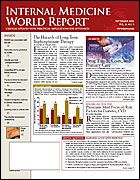Publication
Article
Internal Medicine World Report
Inhaled Insulin: Self-Training as Effective as Expert Training
Author(s):
From the American Diabetes Association
WASHINGTON, DC?Successful use of inhaled insulin does not require intensive training. In a study of patients with type 2 diabetes, those who read the directions for use and tried using the system on their own were just as likely to use it effectively and without adverse events as those who received intensive training, said Julio Rosenstock, MD, of the Dallas Diabetes and Endocrine Center and the University of Texas Southwestern Medical School, also in Dallas, at the 66th Scientific Sessions of the American Diabetes Association.
Ease of use "may allow further reduction in barriers to starting insulin therapy," said Dr Rosenstock. "Self-directed training?using only the directions for use was sufficient to achieve safe and effective results similar to those achieved with intensive educator-directed training."
In the study, 102 insulin na?ve patients with type 2 diabetes who were receiving background therapy of metformin (Glucophage) with or without a thiazolidinedione were randomized to either standard training or intensive educator-directed training for the safe and effective use of the inhaled insulin system.
The group assigned to standard training learned the system by reading the directions and trying it on their own. Those assigned to intensive training attended an orientation session, were individually supervised on using the system, and received training on inspiratory flow rates to optimize inhalation flow rate and duration. They also had access to a telephone help line and received instructions on starting doses and dose titration.
At 4 weeks, 2-hour postprandial blood glucose excursions based on self-monitored blood glucose values were significantly and similarly decreased in both groups.
Overall glycemic control also improved similarly in the 2 groups: hemoglobin (Hb) A1c fell by 0.49% and 0.65% from baseline to 4 weeks in the standard and intensive training groups, respectively, a nonsignificant difference. Inhaled insulin dose requirements were also comparable in both groups.
Overall, compliance with the directions for use was >90% in each group.
There was no significant difference in the rate of any adverse event between the 2 groups. The most frequent side effect was cough, reported by 7.8% of the study group.
Overall, rates of hypoglycemia were low but significantly increased from baseline in both of the training groups.
Body weight increased by 1.62 kg in the standard training group and by 1.03 kg in the intensive training group, a nonsignificant difference.
A significant decrease from baseline in forced expiratory volume in 1 second and forced vital capacity was observed in both groups. Total lung capacity decreased significantly from baseline in the standard training group, whereas the diffusing capacity of the lung for carbon monoxide decreased significantly from baseline in the intensive training group.
Data from a phase 3 trial that included 635 adults with type 2 diabetes receiving injected insulin therapy at baseline were also reported at the meeting. In this study, the patients who were randomized to inhaled insulin had similar improvements in or maintenance of HbA1c values after 2 years compared with those who continued to receive insulin injections. Those randomized to inhaled insulin, however, had slightly better fasting blood glucose levels.
This study builds on earlier data demonstrating that inhaled insulin can improve blood glucose control when used as monotherapy or added to oral therapy in patients with type 2 diabetes who were not controlled with use of oral therapy alone, said Dr Rosenstock.






